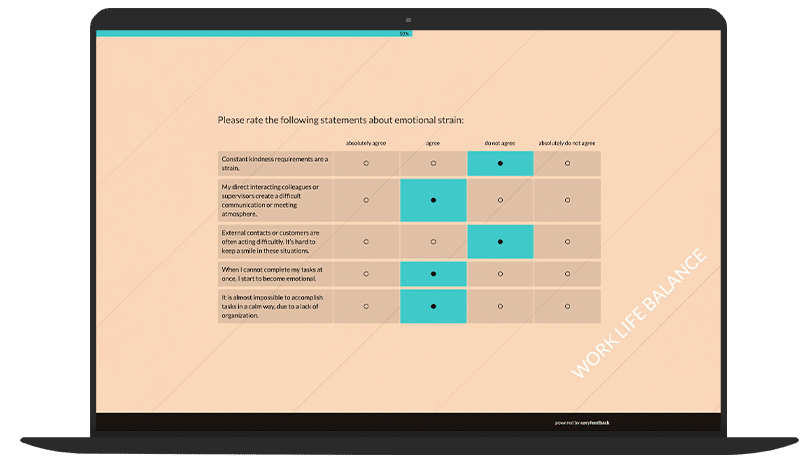Option 1: Identification of health risks
Through targeted employee surveys, you as a company can identify health risks and stress factors in the workplace.
This is crucial for recognizing potential hazards early on and taking appropriate measures to reduce risks.
For example, surveys on ergonomics in the workplace can show whether your employees have problems with their working environment that could lead to health complaints.

Such surveys could include questions about sitting posture, the arrangement of work equipment, the quality of chairs and desks and other ergonomic factors.
By analyzing the survey results, you can identify possible ergonomic risks that could lead to back problems, muscle tension or other physical complaints.
Based on this, you can then take targeted measures to improve the working conditions of your employees and reduce the risk of work-related injuries or illnesses.
This could include, for example, adapting the workplace, providing ergonomic furniture or participating in training programs on correct posture and working methods.
Ultimately, such measures not only contribute to the health and well-being of your employees, but can also increase productivity and reduce sickness rates in the long term.
Option 2: Recognizing stress factors
Surveys can also help to identify stress factors in the workplace that can have a negative impact on the health of your employees.
Stress is a common cause of health problems and can have both physical and psychological effects.

Through surveys, you can identify various stressors that your employees are exposed to, such as high workloads, time pressure, conflicts in the workplace or insufficient resources.
By understanding employee stress ors, your company can take targeted measures to improve working conditions and reduce stress-related illnesses.
These measures could include a range of interventions, such as implementing stress management programs, promoting work-life balance, providing resources to manage stress or fostering a supportive and respectful work culture.

In addition, surveys can help raise awareness of stress management techniques and give employees the opportunity to provide feedback and make suggestions to improve the working environment.
By specifically identifying and managing stress factors, companies can not only improve the health and well-being of employees, but also increase productivity and reduce sickness rates in the long term.
A healthy and stress-free working environment helps to keep your employees motivated, engaged and productive, which in turn has a positive impact on the entire company.
Option 3: Feedback on health programs
You can use surveys to gather feedback on health and wellness programs that your company may have implemented.
These programs can include various activities and initiatives, such as fitness classes, nutritional counseling, stress management training or smoking cessation programs.

By having your employees share their opinions and experiences, your company can better assess which programs are effective and which may need to be adjusted or expanded to better meet their needs.
Surveys can help evaluate the effectiveness of the programs and gather feedback on various aspects, such as the accessibility of the programs, the quality of services offered, employee interest and overall satisfaction.
Based on this, you can then make targeted improvements to make the programs more attractive and effective.
This could include adjusting course times or content, introducing new offerings or providing additional resources.
In addition, surveys can help raise awareness of existing health and wellness programs and increase participation.
By communicating the results and implementing feedback, your company can increase employee engagement in the programs and encourage positive long-term behavior change.
Option 4: Raising awareness and education
Surveys can also help to raise awareness of health issues and encourage you as a company to actively look after the health of your employees.
For example, surveys could be used to gauge interest in various health topics among your employees and develop targeted training or education programs.
By participating in surveys, you can not only better understand the health needs of your employees, but also gain information and resources to actively contribute to a healthier lifestyle.

Such surveys could include questions on preferred health topics, the level of knowledge on various health aspects and preferences for training or information formats.
On this basis, you can then develop training programs that are tailored to the needs and interests of your employees.
This could include running workshops on specific health topics, providing informative materials or setting up health campaigns.
By specifically promoting health awareness, companies can create a culture of mindfulness and care for health.
This not only helps to improve individual wellbeing, but can also boost overall team performance and productivity.
Employees who consciously look after their health are often more energetic, focused and less prone to sickness absence.
Surveys can therefore make an important contribution to creating a healthy and supportive working environment that promotes your well-being and performance.
Conclusion
In conclusion, surveys can make a significant contribution to promoting employee health and well-being in the workplace.
Through targeted surveys, you can not only identify potential health risks and stressors, but also raise employee awareness of health issues and encourage them to actively engage in their own health.
In addition, surveys allow companies to gather feedback on health and wellness programs and continuously improve them to better meet the needs of employees.
A healthy and supportive work environment fostered through surveys can not only increase individual employee well-being, but also improve overall team performance and productivity.
Overall, surveys are an important tool for organizations to create a culture of mindfulness and care for health and promote the long-term well-being of their employees.
More on the topic of employee retention
- Why employee retention is more important than ever
- 6 methods to measure employee retention
- Employee Net Promotor Score (eNPS): measuring employee loyalty
- 6 pillars of employee retention
- 8 measures to increase employee retention
- The turnover rate: a key figure for measuring employee retention
- How surveys can help reduce employee turnover!
- The sickness absence rate: an indicator of employee loyalty






